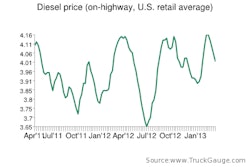Coinciding today with the Truckload Carriers Associations’ annual convention in Las Vegas, Nev., Rand McNally released its all-new Connect web portal. The portal enables a single point for users to view all of the metrics, features, and services connected with Rand McNally’s TND 760 and TPC 7600 mobile fleet management products.
The Connect web portal features a dashboard view that allows fleet managers to see trends and key performance indicators quickly, for a specified time period, and then to drill into business issues via detailed reports. With the click of a button, reports can be exported to a spreadsheet for further analysis.
“Our goal with the Rand McNally Connect web portal is to provide a scalable management platform for our customers’ operations. From a single sign-on, managers and dispatchers have a seamless portal that will manage not only Rand McNally mobile devices but incremental, value added services our customers will find integral to managing their operations such as fuel tax, CSA scoring and others,” said Jim Rodi, senior vice president mobile communications, Rand McNally.
Also included in the new portal release are the following features:
- Dynamic mapping, which combines location intelligence with a visually based user interface, featuring a robust set of geo-spatial tools allowing for a “war room” like user experience.
- A Geofence program that allows complex polygon “fences” to be drawn around customer locations, terminals, routes, and more, enabling alerts and reports on vehicle activity.
- A POI Manager, which saves important locations to the mapping interface, is ideal for viewing customer locations, terminals, and more.
In addition to the new portal, Rand McNally announced that it will be integrating a host of value-added services. These services will pull data from the Rand McNally mobile fleet management devices and provide insight into business challenges such as driver behavior/CSA scoring, fuel-tax reporting, and event analysis for improving training and safety.
SpeedGauge is the first of these services to be fully integrated with the Connect web portal. SpeedGauge will use the GPS tracking information from the Rand McNally devices to identify the location, frequency, severity and duration of speeding events. Fleet managers subscribing to the service can create customized reports, considering context (“where exactly was the driver speeding?”) and analysis (“is this particular driver doing better or worse than last week?”). The reports allow managers to address driver behavior, and to track improvements over time, while reducing the opportunity for additional citations when a driver is pulled over for speeding.
In addition to the financial benefits of monitoring and controlling for speed, the resulting positive impact to CSA scores can solidify a fleet’s relationships with shippers, who are increasingly aware of and making business decisions based on a carrier’s CSA scores.
The value-added services will be available directly from the new Connect web portal.














